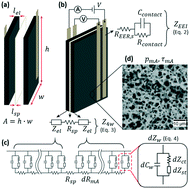Understanding resistances in capacitive deionization devices†
Abstract
The desalination characteristics of capacitive deionization (CDI) are significantly impacted by the cell resistance. Here we apply electrochemical impedance spectroscopy (EIS) to analyze the resistive properties of a CDI device, which include EIS measurements on a complete assembled cell (in two wire mode) and EIS measurements with additional contacts to decouple electrode/electrolyte and contact impedances (four wire mode). These measurements shed light on the interface between current collector and electrode as well as the internal capacitive and resistive elements of the cell. With two-wire and four-wire EIS measurements, we find that the often observed high-frequency arc(s) in the impedance spectra can be due to contact effects and/or an internal ionic-transfer resistance that is locally in parallel with macropore wall capacitance. In some cases, the two associated arcs in the Nyquist plot are overlapping and present simultaneously, making their identification in the EIS spectra difficult unless both two-wire and four-wire measurements are made. Despite causing a large high-frequency arc in the Nyquist plot, we find that the apparent internal ionic-transfer resistance is negligible compared to the resistances of the electrode, separator, and external electronic components. An investigation of the contact impedance between the electrode and current collector reveals a parallel RC arc that can grow over time if an improper material is used (e.g., titanium). In our system, the electrode ionic resistance dominates the total Ohmic power dissipation, which has implications for scale-up of CDI systems and future improvements of cell design.

- This article is part of the themed collection: Capacitive deionisation and electrosorption 2020


 Please wait while we load your content...
Please wait while we load your content...